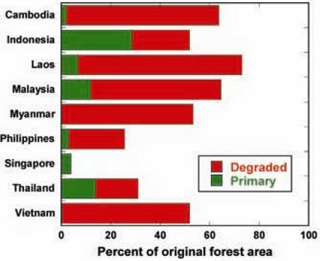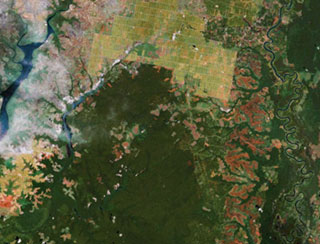Rainforest destruction continues apace in tropical Asia
Rainforest destruction continues apace in tropical Asia
Rhett A. Butler, mongabay.com
December 9, 2007
Tropical forests in Asia have been rapidly and extensively destroyed over the past generation, with significant implications for the region’s biodiversity and global climate.
A new study, published in the December volume of Current Science, finds that Asian forest loss has occurred mostly in poor, corrupt countries that have high population density and robust population growth rates.
Analyzing forest cover data and economic and demographic figures, Dr. William Laurance of Smithsonian Tropical Research Institute in Panama, shows that half of tropical Asian nations have already lost more than 70 percent of their forest cover, while the pace of deforestation across the region (0.8-0.9 percent per year) has been about twice as high as rates in Latin America and Africa (0.4-0.5 percent per year). Worryingly, Laurance says that clearing in forest-rich countries like Indonesia and Malaysia appears to be increasingly driven by large-scale commercial activities like industrial agriculture and logging rather than subsistence farming by small-holders, suggesting that the link between population density and forest exploitation may be diminishing in significance. The trend, fueled by economic globalization including surging Chinese demand for natural resources, is important because it indicates that urbanization — which some analysts believe will reduce pressure on forest areas, thereby allowing regeneration of forests on abandoned agricultural lands — may not be may not be a panacea for forest recovery.
 Estimated percentage of degraded and primary forest for selected Asian tropical nations, based on a recent analysis. Degraded forests include logged and secondary forests and plantations. Courtesy of Current Science. |
“It is important to emphasize… that industrial drivers have clearly increased in importance in recent decades as a proximate cause of tropical forest conversion,” writes Laurance. “In tropical Asia, among the most important of such industrial drivers are selective logging, largescale plantations of oil-palm and rubber trees and mineral exploitation. Such activities not only directly destroy or degrade forests, but they also provide a key economic impetus for road-building in forested areas. Such roads greatly increase physical accessibility to forests for colonists, hunters and swidden farmers.”
“As industrialization and globalization further increase in tropical Asia, the strong relationship between local population density and forest cover may begin to weaken, because even sparsely populated countries can be intensively exploited in a globalized world,” he continues.
Protected areas in tropical Asia
 Deforestation near Tanjung Puting in Kalimantan on the island of Borneo. Satellite image courtesy of Google Earth. |
While protected areas could help slow the impact of industrial conversion of natural forests, Laurance says that conservation efforts in some tropical Asian countries have shown “mixed” results due to corruption and resource availability outside protected areas.
“Many protected areas are being isolated and degraded by illegal logging, hunting and other forms of encroachment,” he writes. “Some reserves have already collapsed ecologically. Protected areas in Peninsular Malaysia and Java are relatively stable, but many in Cambodia, Vietnam, Laos, the Philippines and Indonesian Borneo are seriously imperiled.”
Laurance argues that improved law enforcement and programs to expand protected areas — like the “Heart of Borneo” initiative to conserve a large swathe of forest in central Borneo — could help limit biodiversity and forest loss in the region, but warns that action must come soon in order to be effective.
“Having spent years working in the Amazon and Central Africa, it’s striking to see how serious the situation is in tropical Asia,” Laurance told mongabay.com. “The fundamental drivers of forest destruction are remarkably intense, and the region contains the greatest concentration of biodiversity hotspots on earth. It’s a tragedy in the making.”
CITATION: William F. Laurance (2007). Forest destruction in tropical Asia. CURRENT SCIENCE, VOL. 93, NO. 11, 10 DECEMBER 2007